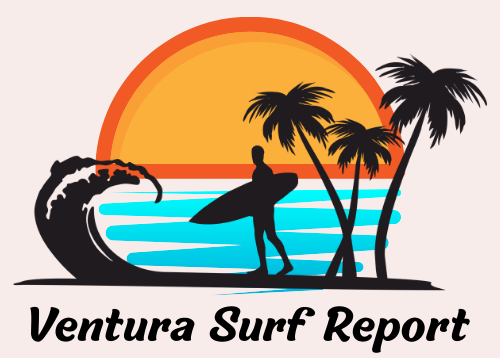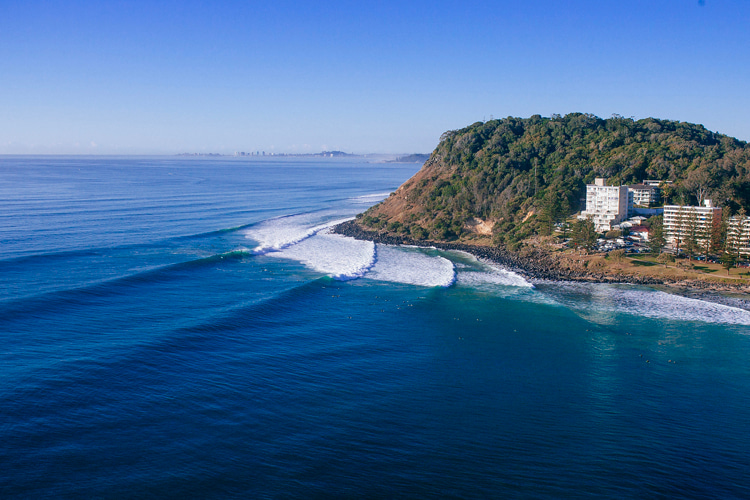
Burleigh Heads is one of the crown jewels of the Gold Coast of Queensland’s surfing treasury. But what makes this tubular, express train wave such a gem in this part of the world?
Someone once said that, when naming towns, Gold Coast authorities missed the real Surfers Paradise by eight miles (13 kilometers).
And there are many reasons for that’s true.
Burleigh Heads is home to The Stubbies Pro, the contest that started in 1977 and kicked off surfing’s first-ever man-on-man heat format.
The peak is a pivotal place in the history of Australian surfing.
The high-performance right-hand point break starts its wave-riding generation journey by the Burleigh Heads Rock Pools and Burleigh Hill and runs around the shoreline toward Burleigh Beach.

Early Rides
According to surf historian Matt Warshaw, author of “The Encyclopedia of Surfing,” “Gold Coast lifeguards were riding the nearby beach breaks as early as the 1920s, but Burleigh’s advanced-level surf remained empty until 1958 when brothers Hugh and John McMaster visited from Brisbane and were able to handle the fast point waves.”
The first event to take place here was the Burleigh Festival of Boards, a single-day club competition held in 1965.
In the same year, the Burleigh Heads Boardriders Club was formed.
By the end of the 1960s, the Australian surf spot was already the home break to some of the country’s best performers, including national champions Keith Paull, Peter Drouyn, and Paul Neilsen.
So, it was no surprise that in the 1970s, Burleigh Heads was producing its own world champions, Peter Townend (1976) and Wayne Bartholomew (1978).
But soon, there were more local surfers shining at an international level: Brad Jeffries, Dave Rastovich, Dick Van Straalen, Guy Ormerod, Jackson Close, Jay Thompson, Joe Engel, Ken Adler, Kyle Robinson, Luke Egan, Michael Peterson, Nick Heath, Peter Drouyn, Dwayne and Peter Harris, Richard Harvey, Ryan Gray, Thornton Fallander, Tony Eltherington, and others.
In 1974, Kirra‘s sibling hosted the Australian National Titles; eight years later, the already popular wave welcomed the Amateur World Surfing Championship.
The Stubbies Pro and the Man-on-Man Heat Format
The cherry on the cake was truly The Stubbies Pro.
The event kicked off in 1977 and was designed by local pro surfer Peter Drouyn.
It went on to define one of competitive surfing’s most long-lasting features: the man-on-man heat format.
The inaugural contest got underway in perfect five-foot surf and saw an already retired Michael Peterson taking the trophy home.
The Stubbies Pro ran until 1986, crowning Wayne “Rabbit” Bartholomew (1978), Mark Richards (1979 and 1981), Peter Harris (1980), Martin Potter (1983), Tom Carroll (1984), Brad Gerlach (1985), and Tom Curren (1986).
Legendary surfboard shaper Nev Hyman once said, “I moved up to Queensland because my dream was to surf Burleigh.”
“I’d see all the photos in Tracks magazine of grinding barrels, and I got there in time to see Michael Peterson win the Stubbies Pro in 1977. It was just epic.”
“There are probably only a few waves in the world where I’ve screamed myself hoarse from excitement, and this is one of them.”
“I’ve had absolutely mindlessly perfect waves – so good it’s like you’re on another planet.”
Today, on good days, Burleigh Heads is super crowded.
However, surfboard shaping veteran Phil Grace noted that it was not always like that.
“I remember going to the Australian Nationals held in Coolangatta in 1966. I was on the Victoria team with Wayne Lynch, and I was riding a nine-foot board.”
“Back then, the tallest building on the Gold Coast was three stories high.”
“We drove up to Burleigh, and in those days, no one was really surfing there – it was too radical a wave for the equipment we were riding at the time.”
When the shortboard revolution created new craft, the opportunities presented by Burleigh Heads were impossible to ignore.
Suddenly, everything became rideable with smaller, more responsive, and faster surfboards.

Ideal Swell and Wind Conditions
The best time of the year to surf Burleigh Heads is between December and March during the tropical cyclone season in the Coral Sea, when E wave trains, but also SE and S groundswells, arrive.
Nevertheless, wintertime (May-August) can generate bigger waves groomed by consistent SW offshore wind.
From September to December, northern winds will be too onshore for this northeast-facing surf break.
Burleigh depends on the amount of sand coming out of the Tallebudgera River before being shaped by prevailing south swells and creating the legendary local sandbar in the lee of the headland.
When these conditions align, barrels will begin to fire in front of the basalt boulder shoreline.
Burleigh Heads generally works best on lower tides.
Daytime air temperatures range from 80 °F (27 °C) in summer to 60 °F (16 °C) in summer in winter, while the water will be between around 68-70 °F (20-26 °C).

The Four Burleigh Head Waves
Burleigh Heads is a freight-train-like, right-hand point break wave.
It comprises four sections that only rarely can link up.
- Sharkies: The first Burleigh peak has a shorter and less organized right-hand wave that breaks in front of the bluff. It’s hollow and thick and could connect to The Cove;
- The Cove: Surfers enter the water as the coastline curves into the bay to get access to a long barreling wave that can easily reach ten feet (three meters);
- The Point: It’s Burleigh Heads’ main peak and provides a long hollow tube and a better-shaped wave, with long walls and plenty of shredding options, including a few left-hand opportunities;
- Rockbreak: On the inside of The Point, you’ll find a short wave that pops on small days during high tide and breaks over the nearby basalt boulders;
The rides can be long, so the best way to get back to the take-off zone is by walking back to the slippery rocks down Burleigh Hill and then taking the rip back to the lineup.
But before you can celebrate victory after a well-ridden wave, you’ve got to be lucky enough to overcome the slippery boulders at the entry point, beat the strong north-running current, and then win the lottery among the more than 100 surfers who, just like you, are looking after the same pot of gold.
The wave has been featured in several surf videos and movies throughout the decades, including “The Hot Generation” (1967), “Fluid Drive” (1974), “Storm Riders” (1982), “Cyclone Fever” (1994), and “Bells 2 Burleigh.”
Today, it is part of the Gold Coast World Surfing Reserve and hosts World Surf League (WSL) events as an alternative to Snapper Rocks.
Threats and Hazards
Surfing Burleigh Heads may not be the idyllic experience you think it is after seeing the water-level pictures of surfers getting deeply barreled with the forest-covered headland as a backdrop.
Getting to the water is itself a challenge, especially if you follow the norm, which is to launch from the slippery rocky entry point near Burleigh Hill.
Then, on medium to big days, paddling out to the lineup can be exhausting. Rip currents can be your friend, but you need to learn them well.
If you make it to the surf zone, get ready for a highly competitive arena where most locals will take most of the waves.
And if you can find an opportunity and priority, they could still drop in on you as if silently telling you who’s in charge.
Bluebottle jellyfish may also invade the surf with NE winds.
Words by Luís MP | Founder of SurferToday.com


Leave a Reply